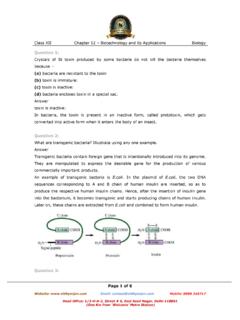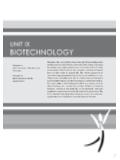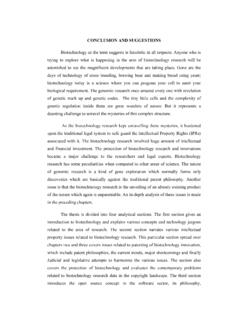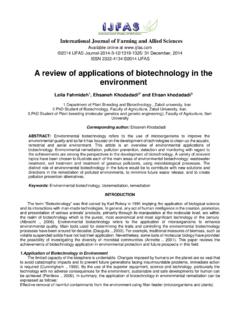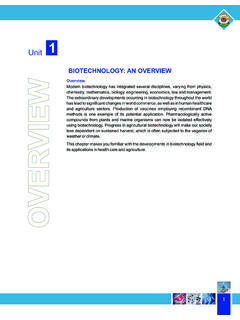Transcription of Biotechnology applications for banana and plantain …
1 Biotechnology Applicationsfor banana and PlantainImprovementBiotechnology applications for banana and plantain ImprovementINIBAP s MandateThe International Network for the Improvement of banana and plantain (INIBAP) wasestablished in 1984 and has its headquarters in Montpellier, France. INIBAP is anautonomous and nonprofit intergovernmental organization whose aim is to increase theproduction of banana and plantain on smallholdings by: initiating, encouraging, supporting, conducting and coordinating research aimed atimproving the production of banana and plantain , with particular reference to thepeople of developing countries; strengthening regional and national programs concerned with improved and disease-free banana and plantain genetic material, and facilitating the interchange of suchmaterial by assisting in the establishment and analysis of regional and global trialsof new and improved cultivars.
2 Coordinating and supporting training programs for developing-country techniciansand for the creation of INIBAP began in 1981 in Ibadan with a resolution passed ata conference of the International Association for Research on plantain and is a member of the Consultative Group on International Agricultural Research(CGIAR). INIBAP 1993B t. 7, Parc Scientifique Agropolis34397 Montpellier Cedex 5, FranceBiotechnology Applicationsfor banana and PlantainImprovementProceedings of the Workshop onheld in San Jos , Costa Rica27-31 January 1992 INTERNATIONAL NETWORK FOR THEIMPROVEMENT OF banana AND PLANTAINThe opinions in this publication are those of the authors and not necessarily those is grateful to all participants, who came from all over the world, for theircontributions to the achievement of the Workshop s objectives. Likewise, INIBAP isgrateful to: The Centro Agron mico de Investigaci n y Ense anza (CATIE), especially to JV Escalant and the staff of the Biotechnology Unit, for hosting and handling the firstday of Workshop sessions.
3 The Corporaci n Bananera Nacional de Costa Rica (CORBANA) for its cooperation inthe local arrangements and for its gracious hospitality. The Dutch Ministry of Foreign Affairs, Special Programme on Biotechnology andDevelopment Cooperation, for sponsoring the production of these proceedings. B Wills and RD Huggan who enthusiastically undertook the task of editing theproceedings, and to F Malafosse for her dedication in preparing the necessarydocuments for the editors. R Jaramillo, Coordinator of the INIBAP Network for Latin America and the Caribbean,who included even his family in the organization and administration of this event. USAID for its participation in the organization of the noteIn some papers references have been submitted without complete publishing data. Theymay therefore lack article titles, the full names of journals, and/or the place ofpublication and the publisher.
4 Unavoidable delays in publication have also led to theomission of full publishing data about some items listed as in press. Should readershave difficulty in identifying particular references, staff at INIBAP will be glad to IntroductionE De Langhe(Director, INIBAP): Opening Speech 7R Tart (Director General, CATIE): Introductory Remarks9I Buddenhagen: Whence and Whither banana Research and Development?12 Part 1: Nonconventional Strategies for Producing banana and plantain Resistant to Pathogens and PestsGenetic MapsD Gonz lez de Le n, S Faur Genetic Mapping of the banana Diploid Genome 29 TransformationF Bakry, R Ha cour, JP Horry, R Megia, L Rossignol applications of Biotechnologies to banana Breeding 52 Identifying and Generating ResistanceC Rivera, P Ram rez, R PereiraPreliminary Characterization of Viruses Infecting banana in Costa Rica63CM Fauquet, RN BeachyStatus of Coat Protein-Mediated Resistance and its Potential Application for banana Viruses69J Dale, T Burns, S Oehlschlager, M Karan, R HardingBanana Bunchy Top Virus85GA Strobel, AA Stierle, R Upadhyay, J Hershenhorn, G MolinaThe Phytotoxins of Mycosphaerella fijiensis93RC PloetzMolecular Approaches to Identifying Fusarium Wilt Resistance104D De WaelePotential of Gene Transfer for Engineering Resistance against Nematode Attack 116N von Mende, P Burrows.
5 J BridgeMolecular Aspects of Resistance to Nematodes125 Cross-Pollination BreedingPR Rowe, FE RosalesBreeding Cooking Bananas for areas with Marginal Growing Conditions128 Part 2: In-Vitro Strategies for MusaGermplasm HandlingO AriasCommercial Micropropagation of banana 139FJ Novak, H Brunner, R Afza, R Morpurgo, RK Upadhyay, M Van Duren, M Sacchi, J Sitti Hawa, A Khatri; G Kahl, D Kaemmer, J Ramser, K WeisingImprovement of Musathrough Biotechnology and Mutation Breeding 143M Perea-DallosContribution to the study of banana Anther Culture159MR S ndahl, C NoriegaBioreactor Micropropagation Technology for Rapid Commercialization Opportunities in Plantation Crops163 Genetic ImprovementD Vuylsteke, R SwennenGenetic Improvemement of Plantains 169JV Escalant, C TeissonSomatic Embryogenesis and Cell Suspensions in Musa177H Leblanc, JV EscalantInduced Parthenogenesis to Obtain Haploid Plants in Musa181W ParrottCell-Culture Techniques183 Somaclonal VariationFX C te, X Perrier, C TeissonSomaclonal Variation in Musasp.
6 192LA WithersEarly Detection of Somaclonal Variation200 Part 3: Technology TransferJA Chambers, JI CohenDonor Assistance in Plant Biotechnology for the Developing World211 Part 4: Recommendations(Working Group 1) Nonconventional Strategies for Producing banana and plantain Resistant to Pathogens and Pests 225(Working Group 2) In-Vitro Strategies for Musa235(Working Group 3) Technology Transfer 236 Annexes1. Acronyms and Abbreviations 2472. Participants249 Introduction7 Opening SpeechE De Langhe Ladies and Gentlemen, this MusaBiotechnology Workshop has been made possiblewith the collaboration and input of several persons and institutes. It is a real pleasurefor me to explain their Rodrigo Tart , Director of CATIE, has been continually and consistentlyencouraging his Center in developing Biotechnology research, and was most supportiveof the initiative to have the workshop take place in Costa Rica.
7 CATIE is the RegionalBase of INIBAP in Latin America and the Caribbean, and INIBAP also considers CATIEas an excellent center for the transfer of new technology into the United States Agency for International Development (USAID) providedsubstantial financial support, allowing the participation of many specialists from theAmerican continent. Moreover, it allowed Dr Judy Chambers to collaborate actively inthe development of the workshop s concept and technical Technical Centre for Agriculture and Rural Cooperation (CTA) of the EECsupports the participation of our colleagues from Africa and from Asia. It will alsofinance the publication of the Ramiro Jaramillo, our Regional Coordinator for Latin American countries, has,during the last 3 weeks, devoted most of his time to the numerous details regarding thepractical organization of the workshop, and the fax-telex line with headquarters,especially with Ms Susan Faur of our secretariat, was red-hot at times.
8 His base ofoperations, during the last few days, was at San Jos airport, rather than at Huggan, our Editor, feels quite comfortable, having already received the text ofabout half of the presentations, and will no doubt be consulting you in the furtherpreparation of the proceedings. His long-standing professional experience is a guaranteeof the quality of that Ivan Buddenhagen has agreed to make the general introduction to the scientificcontributions, and I have no doubt that he will do this in his typically provocative andneuron-stimulating Germplasm Research Coordinator, Hugues Tezenas du Montcel, and our CropProtection Research Coordinator, David Jones, are here and are of course readilyavailable to provide any technical information you may wish to ask attaches particular importance to the recommendations of this workshopand on their follow-up within the Network.
9 The background paper, which you havealready received, explains what we expect from this event, and I will, by the end of thepresentations, elaborate on how INIBAP expects to be helpful as a LangheDirector, INIBAPI am confident that the workshop will be productive in several senses. A good manyscientific contacts will be made which is part of INIBAP s task, to encourage informalnetworking. If the workshop formulates guidelines regarding INIBAP s future role inMusabiotechnology, then its output will be SpeechIntroductory RemarksR Tart On behalf of the Tropical Agricultural Research and Training Center (CATIE), I wantto extend the warmest welcome to all participants in this extremely important you all know, CATIE has been the host for INIBAP s regional coordination forLatin America and the Caribbean. We have, together, undertaken several importantactivities with the purpose of improving the production of bananas and plantains in theregion.
10 Those activities are oriented towards coordinating the research efforts conductedby many institutions committed to this goal at a global level. The search for newtechnologies, the exchange of information, and the performance of joint collaborativeactivities require an institutional complementarity that must avoid the unnecessaryduplication of complementarity and collaboration are regarded by CATIE as the mostimportant elements of its strategic development. They are also, I believe, the essence ofa networking mechanism like that promoted by INIBAP. And complementarity andcollaboration are the only ways of facing today s challenges of agricultural research anddevelopment: the challenge of increasing productivity while maintaining the naturalresource base the challenge of making agriculture sustainable, not only ecologically,but also economically, socially, and challenges perhaps comprise a greater challenge than the one faced by thosewhose research led to the Green Revolution some 30 years and disciplinary research has evolved over many years intomultidisciplinary farm research, and today into what we call multidimensional because the search for agricultural development that is sustainablemust take into account the different dimensions involved in an integrated way: theecological, the economic, the social, the cultural, the policy, and the institutionaldimensions.

